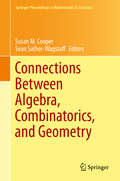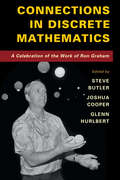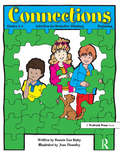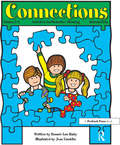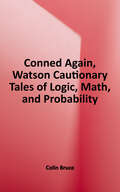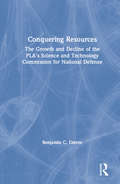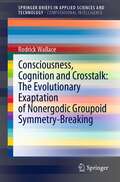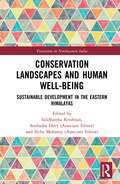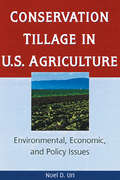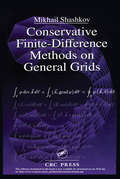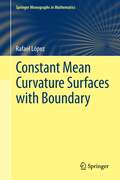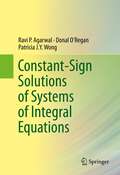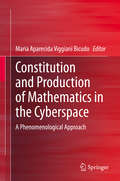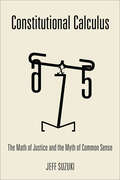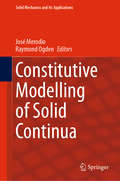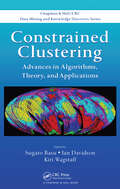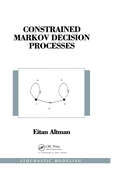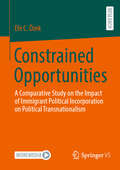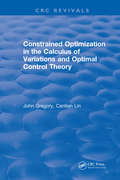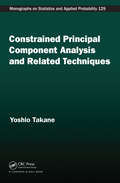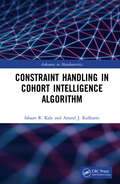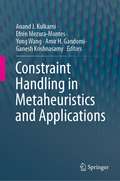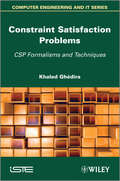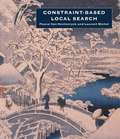- Table View
- List View
Connections Between Algebra, Combinatorics, and Geometry (Springer Proceedings in Mathematics & Statistics #76)
by Susan M. Cooper Sean Sather-WagstaffCommutative algebra, combinatorics, and algebraic geometry are thriving areas of mathematical research with a rich history of interaction. Connections Between Algebra and Geometry contains lecture notes, along with exercises and solutions, from the Workshop on Connections Between Algebra and Geometry held at the University of Regina from May 29-June 1, 2012. It also contains research and survey papers from academics invited to participate in the companion Special Session on Interactions Between Algebraic Geometry and Commutative Algebra, which was part of the CMS Summer Meeting at the University of Regina held June 2-3, 2012, and the meeting Further Connections Between Algebra and Geometry, which was held at the North Dakota State University February 23, 2013. This volume highlights three mini-courses in the areas of commutative algebra and algebraic geometry: differential graded commutative algebra, secant varieties, and fat points and symbolic powers. It will serve as a useful resource for graduate students and researchers who wish to expand their knowledge of commutative algebra, algebraic geometry, combinatorics, and the intricacies of their intersection.
Connections in Discrete Mathematics: A Celebration of the Work of Ron Graham
by Steve Butler Joshua Cooper Glenn HurlbertDiscrete mathematics has been rising in prominence in the past fifty years, both as a tool with practical applications and as a source of new and interesting mathematics. The topics in discrete mathematics have become so well developed that it is easy to forget that common threads connect the different areas, and it is through discovering and using these connections that progress is often made. For over fifty years, Ron Graham has been able to illuminate some of these connections and has helped to bring the field of discrete mathematics to where it is today. To celebrate his contribution, this volume brings together many of the best researchers working in discrete mathematics, including Fan Chung, Erik D. Demaine, Persi Diaconis, Peter Frankl, Alfred W. Hales, Jeffrey C. Lagarias, Allen Knutson, Janos Pach, Carl Pomerance, N. J. A. Sloane, and of course, Ron Graham himself.
Connections: Activities for Deductive Thinking (Beginning, Grades 3-4)
by Bonnie L. RisbyThese imaginative puzzles are the pinnacle of this classic series designed to sharpen deductive reasoning skills and strengthen the ability to sort through information by formulating connections. Created with the classroom teacher in mind, these puzzles are both intriguing and easy to fit into lesson plans for the gifted and talented, as well as many main course curriculums. Designed for teachers frustrated with complicated logic exercises that are beyond the scope of one class period, Connections are formatted for success within 50-minute pullout programs.Each puzzle includes an introduction, clues, a grid, and an illustration. Many educators have found Connections the best exercise to introduce deductive reasoning skills while enhancing enthusiasm. Exercises are simple to use and gradually present ever-increasing challenges. The thinking skills introduced dovetail easily into other aspects of the curriculum. Capture students' attention and challenge their intellectual talents with this first-rate series. The size of the grids is an indication of difficulty. This book is the most advanced in this series. For easier deductive thinking grids, check out Connections (Introductory), Connections (Beginning), and Connections (Intermediate). Grades 6-8
Connections: Activities for Deductive Thinking (Introductory, Grades 2-4)
by Bonnie L. RisbyThese imaginative puzzles are the pinnacle of this classic series designed to sharpen deductive reasoning skills and strengthen the ability to sort through information by formulating connections. Created with the classroom teacher in mind, these puzzles are both intriguing and easy to fit into lesson plans for the gifted and talented, as well as many main course curriculums. Designed for teachers frustrated with complicated logic exercises that are beyond the scope of one class period, Connections are formatted for success within 50-minute pullout programs.Each puzzle includes an introduction, clues, a grid, and an illustration. Many educators have found Connections the best exercise to introduce deductive reasoning skills while enhancing enthusiasm. Exercises are simple to use and gradually present ever-increasing challenges. The thinking skills introduced dovetail easily into other aspects of the curriculum. Capture students' attention and challenge their intellectual talents with this first-rate series. The size of the grids is an indication of difficulty. This book is the most advanced in this series. For easier deductive thinking grids, check out Connections (Introductory), Connections (Beginning), and Connections (Intermediate). Grades 6-8
Conned Again, Watson: Cautionary Tales of Logic, Math, and Probability
by Colin BruceIn this book, the author re-creates the atmosphere of the original Sherlock Holmes stories to shed light on an enduring truth: Our reliance on common sense—and ignorance of mathematics—often get us into trouble. In these cautionary tales of greedy gamblers, reckless businessmen, and ruthless con men, Sherlock Holmes uses his deep understanding of probability, statistics, decision theory, and game theory to solve crimes and protect the innocent. But it's not just the characters in these well-crafted stories that are deceived by statistics or fall prey to gambling fallacies. We all suffer from the results of poor decisions. <p><p>In this illuminating collection, Bruce entertains while teaching us to avoid similar blunders. From "The Execution of Andrews" to "The Case of the Gambling Nobleman," there has never been a more exciting way to learn when to take a calculated risk and how to spot a scam.
Conquering Resources: The Growth and Decline of the PLA's Science and Technology Commission for National Defense
by Benjamin C. Ostrov Richard P. SuttmeierThis case study seeks to explain how organizations grow and the limits to that growth when an organization engaged in policy implementation lacks the resources necessary to achieve policy goals. The discussion of the basis of conflict that emerges from this study is of lasting significance. For years, studies of this issue have pointed to various models of factionalism, stressing the informal character of the groups involved. In Professor Ostrov's study, however, conflict is shown to have a supra-Cultural Revolutionary institutional basis in this and other key units.
Consciousness, Cognition and Crosstalk: The Evolutionary Exaptation of Nonergodic Groupoid Symmetry-Breaking (SpringerBriefs in Applied Sciences and Technology)
by Rodrick WallaceThis book makes application to the dynamics of arousal and distraction, and to other examples. A modified version of the Kadanoff picture of phase transitions in consciousness emerges from the Morse Function itself in a surprisingly standard manner, closely associated with the breaking of groupoid symmetries driven by fundamental equivalence class algebras. Although this is far indeed from the familiar world of physical theory, it should be possible, on the basis of the probability models developed in the book, to develop new statistical tools for the analysis of observational and empirical data regarding cognition and consciousness.
Conservation Landscapes and Human Well-Being: Sustainable Development in the Eastern Himalayas (Transition in Northeastern India)
by Siddhartha KrishnanThe Himalayas are said to be the youngest mountain ranges in the world. This book studies the well-being of the eastern Himalayan forest-dwellers in terms of their capabilities and functioning. Using Amartya Sen’s and Martha Nussbaum’s Capabilities Approach, it examines the educational and health opportunities and substantial freedoms afforded to farmers and pastoralists living and working in the Senchal and Singalila Protected Areas of North Bengal, India. It also discusses the challenges and potential of the Forest Rights Act as a well-being delivery mechanism. The book adopts a comparative narrative of socio-ecological information generated from interviews, ecological field methods, remote sensing and participatory rural appraisals to provide insight on human development in conservation contexts. This volume will be of interest to students and researchers of conservation biology, development studies, socio-ecological systems studies, political ecology, human development index, ecological economics, environmental sociology, and South Asian studies. It will also be useful to policy-makers and NGOs in the conservation and livelihoods sector.
Conservation Tillage in U.S. Agriculture: Environmental, Economic, and Policy Issues
by Noel UriDiscover farming techniques that will decrease soil erosion and costs!Soil erosion from U.S. croplands has long been recognized as a national problem. Conservation Tillage in U.S. Agriculture: Environmental, Economic, and Policy Issues is the first ever complete study of the costs and benefits of using conservation tillage to prevent soil erosion. Designed for professionals working in the areas of soil science, agronomy, economics, environmental studies, and agriculture, this complete study covers everything from machinery and trends in conservation tillage to its adoption to use in regions of the United States.With this in-depth manual, you will examine different types of tillage and the many benefits this practice can ensure, such as improving water quality, increasing organic matter in your soil, sequestering carbon, and providing habitat and food for wildlife. Covering the economic, environmental, and policy issues of this practice, Conservation Tillage in U.S. Agriculture features: the history of conservation tillage case studies on costs and benefits of differing conservation tillage practices with various crops tables and graphs of trends, and case studies concerning the use of different farming methods U.S. Department of Agriculture soil conservation policies how to prevent soil erosion without harming the environment factors affecting conservation tillage, adoption, and use for crops such as peanuts, potatoes, beets, tobacco, and vegetables. With the help of this book, you will measure the benefits and costs of conservation tillage based on profitability and environmental impact and explore the positive and negative environmental consequences that may involve air, land, water, and/or the health and ecological status of wildlife. Conservation Tillage in U.S. Agriculture is a timely and informative look at conservation tillage practices that will help you improve residue management and create better conditions for wildlife and the environment.
Conservative Finite-Difference Methods on General Grids (Symbolic & Numeric Computation #6)
by Mikhail ShashkovThis new book deals with the construction of finite-difference (FD) algorithms for three main types of equations: elliptic equations, heat equations, and gas dynamic equations in Lagrangian form. These methods can be applied to domains of arbitrary shapes. The construction of FD algorithms for all types of equations is done on the basis of the support-operators method (SOM). This method constructs the FD analogs of main invariant differential operators of first order such as the divergence, the gradient, and the curl. This book is unique because it is the first book not in Russian to present the support-operators ideas.Conservative Finite-Difference Methods on General Grids is completely self-contained, presenting all the background material necessary for understanding. The book provides the tools needed by scientists and engineers to solve a wide range of practical engineering problems. An abundance of tables and graphs support and explain methods. The book details all algorithms needed for implementation. A 3.5" IBM compatible computer diskette with the main algorithms in FORTRAN accompanies text for easy use.
Constant Mean Curvature Surfaces with Boundary (Springer Monographs in Mathematics)
by Rafael LópezThe study of surfaces with constant mean curvature (CMC) is one of the main topics in classical differential geometry. Moreover, CMC surfaces are important mathematical models for the physics of interfaces in the absence of gravity, where they separate two different media, or for capillary phenomena. Further, as most techniques used in the theory of CMC surfaces not only involve geometric methods but also PDE and complex analysis, the theory is also of great interest for many other mathematical fields. While minimal surfaces and CMC surfaces in general have already been treated in the literature, the present work is the first to present a comprehensive study of "compact surfaces with boundaries," narrowing its focus to a geometric view. Basic issues include the discussion whether the symmetries of the curve inherit to the surface; the possible values of the mean curvature, area and volume; stability; the circular boundary case; and the existence of the Plateau problem in the non-parametric case. The exposition provides an outlook on recent research but also a set of techniques that allows the results to be expanded to other ambient spaces. Throughout the text, numerous illustrations clarify the results and their proofs. The book is intended for graduate students and researchers in the field of differential geometry and especially theory of surfaces, including geometric analysis and geometric PDEs. It guides readers up to the state-of-the-art of the theory and introduces them to interesting open problems.
Constant-Sign Solutions of Systems of Integral Equations
by Ravi P. Agarwal Donal O'Regan Patricia J. Y. WongThis monograph provides a complete and self-contained account of the theory, methods, and applications of constant-sign solutions of integral equations. In particular, the focus is on different systems of Volterra and Fredholm equations. The presentation is systematic and the material is broken down into several concise chapters. An introductory chapter covers the basic preliminaries. Throughout the book many examples are included to illustrate the theory. The book contains a wealth of results that are both deep and interesting. This unique book will be welcomed by mathematicians working on integral equations, spectral theory, and on applications of fixed point theory and boundary value problems.
Constitution and Production of Mathematics in the Cyberspace: A Phenomenological Approach
by Maria Aparecida Viggiani BicudoThis book brings together various studies that assume phenomenology to analyze how mathematics education is affected by the experience of being in the cyberspace. The authors of the chapters included in this contributed volume work with the theoretical framework developed by authors such as Edmund Husserl, Martin Heidegger and Maurice Merleau-Ponty to investigate how mathematics is produced and comprehended in a new way of being in the world, with digital technologies. The aim of this book is not to explain the tools used and how one works with them in the cyberspace, aiming at better teaching and learning mathematics. Its purpose is to present philosophical investigations that contribute to the understanding of the complexity of the world in which we are being researchers and mathematics teachers. By doing so, Constitution and Production of Mathematics in the Cyberspace – A Phenomenological Approach will help researchers and mathematics teachers understand their role in a world in which the experience of teaching and learning mathematics is being radically changed by new technologies and new ways of being in this world.
Constitutional Calculus: The Math of Justice and the Myth of Common Sense
by Jeff SuzukiHow math trumps tradition in promoting justice, fairness, and a more stable democracy.How should we count the population of the United States? What would happen if we replaced the electoral college with a direct popular vote? What are the consequences of allowing unlimited partisan gerrymandering of congressional districts? Can six-person juries yield verdicts consistent with the needs of justice? Is it racist to stop and frisk minorities at a higher rate than non-minorities? These and other questions have long been the subject of legal and political debate and are routinely decided by lawyers, politicians, judges, and voters, mostly through an appeal to common sense and tradition.But mathematician Jeff Suzuki asserts that common sense is not so common, and traditions developed long ago in what was a mostly rural, mostly agricultural, mostly isolated nation of three million might not apply to a mostly urban, mostly industrial, mostly global nation of three hundred million. In Constitutional Calculus, Suzuki guides us through the U.S. Constitution and American history to show how mathematics reveals our flaws, finds the answers we need, and moves us closer to our ideals. From the first presidential veto to the debate over mandatory drug testing, the National Security Agency's surveillance program, and the fate of death row inmates, Suzuki draws us into real-world debates and then reveals how math offers a superior compass for decision-making. Relying on iconic cases, including the convictions of the Scottsboro boys, League of United Latin American Citizens v. Perry, and Floyd v. City of New York, Suzuki shows that more math can lead to better justice, greater fairness, and a more stable democracy. Whether you are fascinated by history, math, social justice, or government, your interest will be piqued and satisfied by the convincing case Suzuki makes.
Constitutional Calculus: The Math of Justice and the Myth of Common Sense
by Jeff SuzukiHow math can make a more stable democracy: &“A breath of fresh air . . . a reaffirmation that mathematics should be used more often to make general public policy.&” —MAA Reviews How should we count the population of the United States? What would happen if we replaced the electoral college with a direct popular vote? What are the consequences of allowing unlimited partisan gerrymandering of congressional districts? Can six-person juries yield verdicts consistent with the needs of justice? Is it racist to stop and frisk minorities at a higher rate than non-minorities? These and other questions have long been the subject of legal and political debate and are routinely decided by lawyers, politicians, judges, and voters, mostly through an appeal to common sense and tradition. But mathematician Jeff Suzuki asserts that common sense is not so common, and traditions developed long ago in what was a mostly rural, mostly agricultural, mostly isolated nation of three million might not apply to a mostly urban, mostly industrial, mostly global nation of three hundred million. In Constitutional Calculus, Suzuki guides us through the U.S. Constitution and American history to show how mathematics reveals our flaws, finds the answers we need, and moves us closer to our ideals. From the first presidential veto to the debate over mandatory drug testing, the NSA&’s surveillance program, and the fate of death row inmates, Suzuki draws us into real-world debates and then reveals how math offers a superior compass for decision-making. Relying on iconic cases, including the convictions of the Scottsboro boys, League of United Latin American Citizens v. Perry, and Floyd v. City of New York, Suzuki shows that more math can lead to better justice, greater fairness, and a more stable democracy.
Constitutive Modelling of Solid Continua (Solid Mechanics and Its Applications #262)
by José Merodio Raymond OgdenThis volume consists of a collection of chapters by recognized experts to provide a comprehensive fundamental theoretical continuum treatment of constitutive laws used for modelling the mechanical and coupled-field properties of various types of solid materials. It covers the main types of solid material behaviour, including isotropic and anisotropic nonlinear elasticity, implicit theories, viscoelasticity, plasticity, electro- and magneto-mechanical interactions, growth, damage, thermomechanics, poroelasticity, composites and homogenization. The volume provides a general framework for research in a wide range of applications involving the deformation of solid materials. It will be of considerable benefit to both established and early career researchers concerned with fundamental theory in solid mechanics and its applications by collecting diverse material in a single volume. The readership ranges from beginning graduate students to senior researchers in academia and industry.
Constrained Clustering: Advances in Algorithms, Theory, and Applications (Chapman & Hall/CRC Data Mining and Knowledge Discovery Series)
by Ian MuehlenhausThis volume encompasses many new types of constraints and clustering methods as well as delivers thorough coverage of the capabilities and limitations of constrained clustering. With contributions from industrial researchers and leading academic experts who pioneered the field, it provides a well-balanced combination of theoretical advances, key algorithmic development, and novel applications. The book presents various types of constraints for clustering and describes useful variations of the standard problem of clustering under constraints. It also demonstrates the application of clustering with constraints to relational, bibliographic, and video data.
Constrained Markov Decision Processes: Stochastic Modeling (Stochastic Modeling Ser. #7)
by Eitan AltmanThis book provides a unified approach for the study of constrained Markov decision processes with a finite state space and unbounded costs. Unlike the single controller case considered in many other books, the author considers a single controller with several objectives, such as minimizing delays and loss, probabilities, and maximization of throughputs. It is desirable to design a controller that minimizes one cost objective, subject to inequality constraints on other cost objectives. This framework describes dynamic decision problems arising frequently in many engineering fields. A thorough overview of these applications is presented in the introduction. The book is then divided into three sections that build upon each other.
Constrained Opportunities: A Comparative Study on the Impact of Immigrant Political Incorporation on Political Transnationalism
by Efe C. ÖzekThis study aims to understand political transnationalism through the political incorporation of migrants in the receiving country. With a qualitative analysis of the perceptions of transnational second-generation Turks towards the political opportunity structures in Germany and the Netherlands, it seeks an answer to the question &‘How do political opportunity structures in the receiving country shape political transnationalism among Turkish migrants in Western Europe?&’ It suggests a causal explanation for the impact of political opportunity structures on political transnationalism through a model called &‘constrained opportunities&’. The empirical results reveal &‘constraints&’ on political opportunity structures that lead to deficient immigrant political incorporation in the country of residence and reinforce political attachment with the country of origin.
Constrained Optimization In The Calculus Of Variations and Optimal Control Theory
by J GregoryThe major purpose of this book is to present the theoretical ideas and the analytical and numerical methods to enable the reader to understand and efficiently solve these important optimizational problems.The first half of this book should serve as the major component of a classical one or two semester course in the calculus of variations and optimal control theory. The second half of the book will describe the current research of the authors which is directed to solving these problems numerically. In particular, we present new reformulations of constrained problems which leads to unconstrained problems in the calculus of variations and new general, accurate and efficient numerical methods to solve the reformulated problems. We believe that these new methods will allow the reader to solve important problems.
Constrained Principal Component Analysis and Related Techniques (Chapman & Hall/CRC Monographs on Statistics and Applied Probability)
by Yoshio TakaneIn multivariate data analysis, regression techniques predict one set of variables from another while principal component analysis (PCA) finds a subspace of minimal dimensionality that captures the largest variability in the data. How can regression analysis and PCA be combined in a beneficial way? Why and when is it a good idea to combine them? Wha
Constraint Handling in Cohort Intelligence Algorithm (Advances in Metaheuristics)
by Anand J. Kulkarni Ishaan R. KaleMechanical Engineering domain problems are generally complex, consisting of different design variables and constraints. These problems may not be solved using gradient-based optimization techniques. The stochastic nature-inspired optimization techniques have been proposed in this book to efficiently handle the complex problems. The nature-inspired algorithms are classified as bio-inspired, swarm, and physics/chemical-based algorithms. Socio-inspired is one of the subdomains of bio-inspired algorithms, and Cohort Intelligence (CI) models the social tendencies of learning candidates with an inherent goal to achieve the best possible position. In this book, CI is investigated by solving ten discrete variable truss structural problems, eleven mixed variable design engineering problems, seventeen linear and nonlinear constrained test problems and two real-world applications from manufacturing domain. Static Penalty Function (SPF) is also adopted to handle the linear and nonlinear constraints, and limitations in CI and SPF approaches are examined. Constraint Handling in Cohort Intelligence Algorithm is a valuable reference to practitioners working in the industry as well as to students and researchers in the area of optimization methods.
Constraint Handling in Metaheuristics and Applications
by Yong Wang Amir H. Gandomi Ganesh Krishnasamy Anand J. Kulkarni Efrén Mezura-MontesThis book aims to discuss the core and underlying principles and analysis of the different constraint handling approaches. The main emphasis of the book is on providing an enriched literature on mathematical modelling of the test as well as real-world problems with constraints, and further development of generalized constraint handling techniques. These techniques may be incorporated in suitable metaheuristics providing a solid optimized solution to the problems and applications being addressed. The book comprises original contributions with an aim to develop and discuss generalized constraint handling approaches/techniques for the metaheuristics and/or the applications being addressed. A variety of novel as well as modified and hybridized techniques have been discussed in the book. The conceptual as well as the mathematical level in all the chapters is well within the grasp of the scientists as well as the undergraduate and graduate students from the engineering and computer science streams. The reader is encouraged to have basic knowledge of probability and mathematical analysis and optimization. The book also provides critical review of the contemporary constraint handling approaches. The contributions of the book may further help to explore new avenues leading towards multidisciplinary research discussions. This book is a complete reference for engineers, scientists, and students studying/working in the optimization, artificial intelligence (AI), or computational intelligence arena.
Constraint Satisfaction Problems: CSP Formalisms and Techniques
by Khaled GhediraA Constraint Satisfaction Problem (CSP) consists of a set of variables, a domain of values for each variable and a set of constraints. The objective is to assign a value for each variable such that all constraints are satisfied. CSPs continue to receive increased attention because of both their high complexity and their omnipresence in academic, industrial and even real-life problems. This is why they are the subject of intense research in both artificial intelligence and operations research. This book introduces the classic CSP and details several extensions/improvements of both formalisms and techniques in order to tackle a large variety of problems. Consistency, flexible, dynamic, distributed and learning aspects are discussed and illustrated using simple examples such as the n-queen problem. Contents 1. Foundations of CSP. 2. Consistency Reinforcement Techniques. 3. CSP Solving Algorithms. 4. Search Heuristics. 5. Learning Techniques. 6. Maximal Constraint Satisfaction Problems. 7. Constraint Satisfaction and Optimization Problems. 8. Distibuted Constraint Satisfaction Problems. About the Authors Khaled Ghedira is the general managing director of the Tunis Science City in Tunisia, Professor at the University of Tunis, as well as the founding president of the Tunisian Association of Artificial Intelligence and the founding director of the SOIE research laboratory. His research areas include MAS, CSP, transport and production logistics, metaheuristics and security in M/E-government. He has led several national and international research projects, supervised 30 PhD theses and more than 50 Master’s theses, co-authored about 300 journal, conference and book research papers, written two text books on metaheuristics and production logistics and co-authored three others.
Constraint-based Local Search
by Pascal Van Hentenryck Laurent MichelThe ubiquity of combinatorial optimization problems in our society is illustrated by the novel application areas for optimization technology, which range from supply chain management to sports tournament scheduling. Over the last two decades, constraint programming has emerged as a fundamental methodology to solve a variety of combinatorial problems, and rich constraint programming languages have been developed for expressing and combining constraints and specifying search procedures at a high level of abstraction. Local search approaches to combinatorial optimization are able to isolate optimal or near-optimal solutions within reasonable time constraints.This book introduces a method for solving combinatorial optimization problems that combines constraint programming and local search, using constraints to describe and control local search, and a programming language, COMET, that supports both modeling and search abstractions in the spirit of constraint programming.After an overview of local search including neighborhoods, heuristics, and metaheuristics, the book presents the architecture and modeling and search components of constraint-based local search and describes how constraint-based local search is supported in COMET. The book describes a variety of applications, arranged by meta-heuristics. It presents scheduling applications, along with the background necessary to understand these challenging problems. The book also includes a number of satisfiability problems, illustrating the ability of constraint-based local search approaches to cope with both satisfiability and optimization problems in a uniform fashion.
